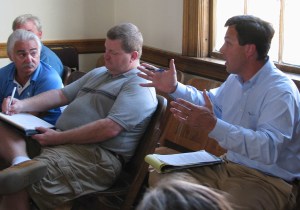RUMFORD — Seven months worth of work by the Wind Power Advisory Committee to craft the town’s first ordinance with which to regulate wind farms ran into stiff turbulence from a few selectmen and a Massachusetts-based wind developer at Thursday night’s workshop.
The 42-page document, which would require among other things, a minimum 1-mile setback of turbines from residences and wind turbines that don’t reflect sunlight, was simply deemed as “not fair” by Selectman Mark Belanger.
Additionally, when asked his opinion, Neil Kiely, project manager for First Wind, the company that has proposed to build a wind farm atop Rumford mountains, said the document as written is “anti-wind power.”
“After reading this document, from my perspective, it would be, in effect, a permanent moratorium on wind development,” Kiely said.
After learning from committee member Charlie Hoff that the document was drafted from Dixmont’s wind ordinance and those of a few other towns, Kiely said the Dixmont ordinance is regarded by the wind industry as anti-wind.
He suggested that selectmen either tweak it more in line with Maine Department of Environmental Protection rules and guidelines pertaining to wind power or follow Roxbury’s wind ordinance regulations.
“The general thrust of this is that it’s not a neutral document,” Kiely said.
He also took issue with the document’s statement that the 1-mile minimum setback “is globally recognized as the absolute minimum setback for 400-foot (tall) turbines.”
“A one mile buffer around the entire project could be 6,000 acres,” Kiely said. “In reality, when working with landowners, putting together a puzzle that large is daunting. What’s the basis for this standard? It’s nine times the standard that DEP recommends for guidance.”
He also attacked the “blade glint” restriction.
That sentence states, “Blade glint, defined as the intermittent reflection of the sun off the surface of the blades of a wind turbine, is prohibited.”
“I’ve never seen that in an ordinance,” Kiely said.
Selectman Jeff Sterling also questioned committee members about that standard and another that would prevent wind energy facilities from creating shadow flicker from the sunlight for more than 10 hours per year at any occupied residence not within the development parcel.
“Isn’t this an impossible scenario?” Sterling asked.
Committee member Jim Thibodeau said it’s from the standpoint of a homeowner in a house and not that of someone out walking.
Thibodeau and other members repeatedly countered the opposition, saying they were tasked by the selectmen with creating an ordinance to protect Rumford residents, above all.
“What we didn’t do is try to make this fit so we could have wind power,” Thibodeau said.
Thibodeau, Hoff and fellow member Peter Buotte also stressed that the ordinance was crafted on the basis that everyone work from a neutral standpoint and put their pro- or anti-wind feelings aside.
That’s why, they said, their document summary states, “The proposed ordinance neither promotes or prohibits industrial wind development.”
Selectman Belanger, however, agreed with Kiely that the document in his opinion was one-sided and anti-business.
“We knew when we got this ordinance that this has to be fair for the town and for any developers and this, to me, is not as fair as I thought it would be,” Belanger said.
“We did what we did for the citizens of Rumford and not the wind power (developers),” Thibodeau reiterated. “I’m not going to present an ordinance developed by wind developers.”
When Kiely suggested basing the ordinance on DEP’s regulations and guidelines, Dan McKay of Dixfield said DEP allows towns to form their own ordinances, even if they’re more restrictive than state guidelines.
“Many towns are realizing that DEP doesn’t cover wind power adequately,” McKay said.
After more discussion, the nearly two-hour meeting abruptly ended without resolution. Selectmen were then formally presented with the document, without discussion, in their board meeting that followed.

Comments are no longer available on this story